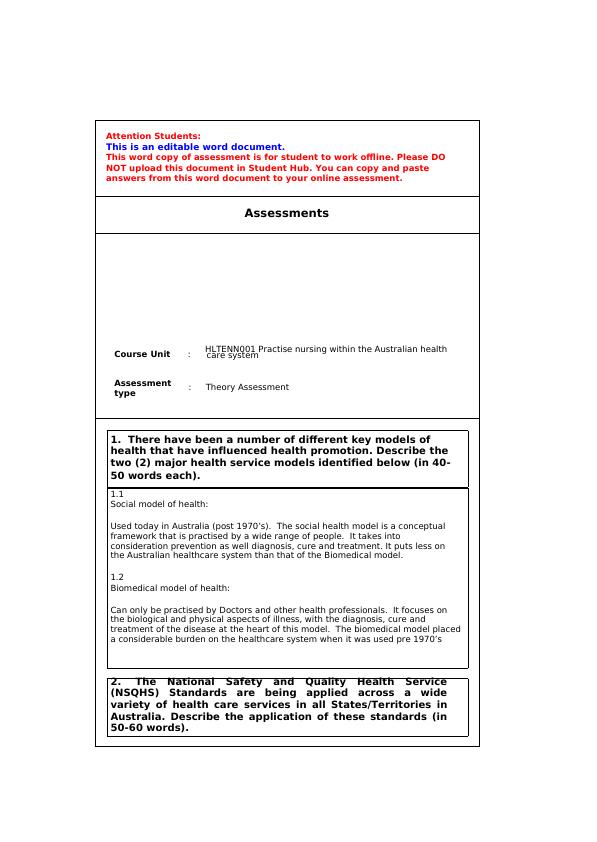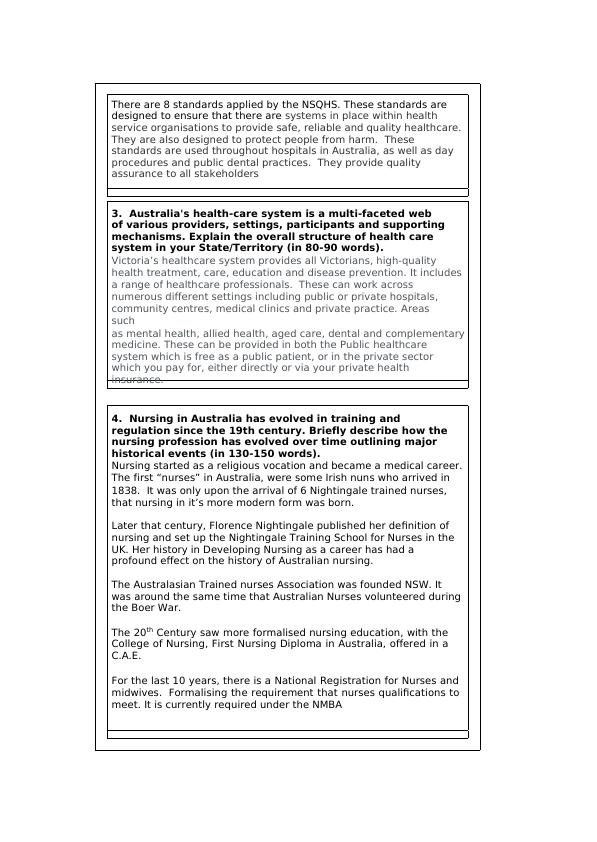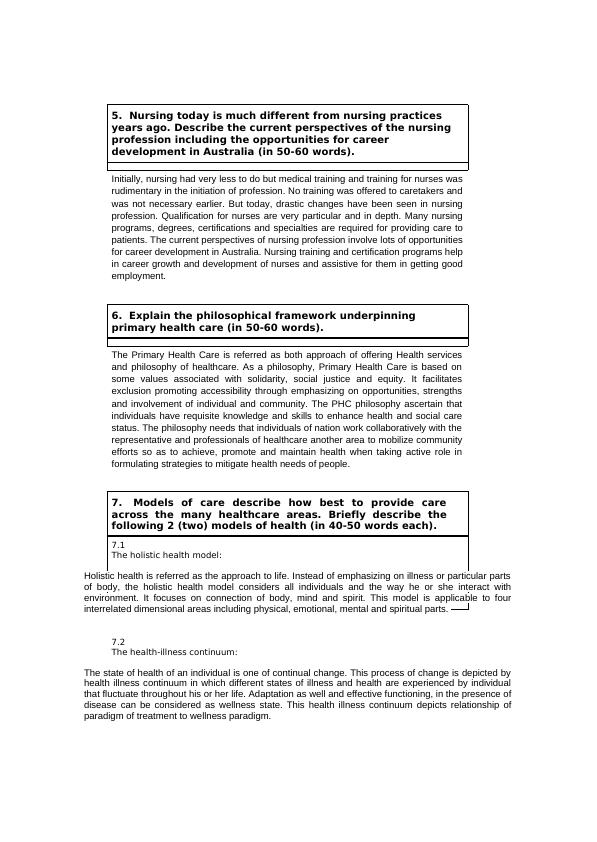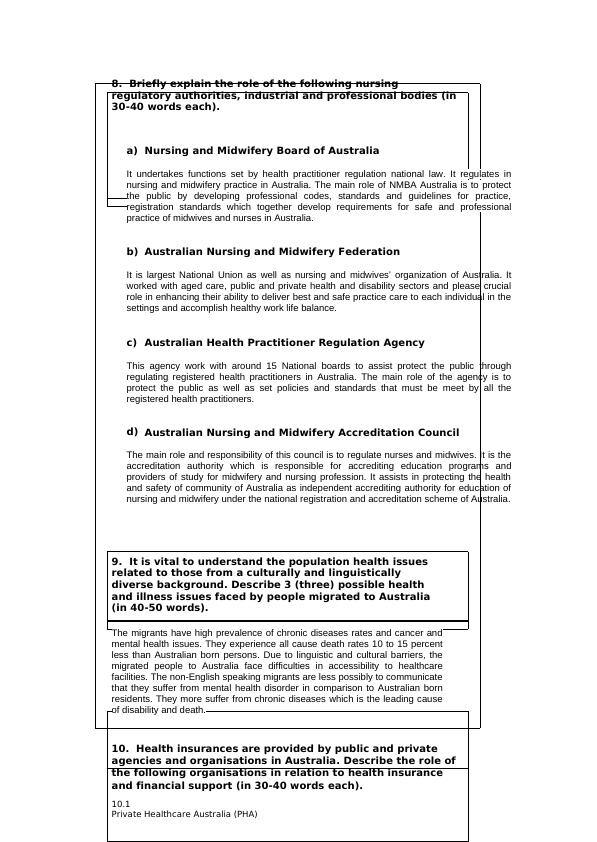Models of Health and Health Care System in Australia
Added on 2023-01-09
13 Pages4784 Words54 Views
Attention Students:
This is an editable word document.
This word copy of assessment is for student to work offline. Please DO
NOT upload this document in Student Hub. You can copy and paste
answers from this word document to your online assessment.
Assessments
Course Unit : HLTENN001 Practise nursing within the Australian health
care system
Assessment
type : Theory Assessment
1. There have been a number of different key models of
health that have influenced health promotion. Describe the
two (2) major health service models identified below (in 40-
50 words each).
1.1
Social model of health:
Used today in Australia (post 1970’s). The social health model is a conceptual
framework that is practised by a wide range of people. It takes into
consideration prevention as well diagnosis, cure and treatment. It puts less on
the Australian healthcare system than that of the Biomedical model.
1.2
Biomedical model of health:
Can only be practised by Doctors and other health professionals. It focuses on
the biological and physical aspects of illness, with the diagnosis, cure and
treatment of the disease at the heart of this model. The biomedical model placed
a considerable burden on the healthcare system when it was used pre 1970’s
2. The National Safety and Quality Health Service
(NSQHS) Standards are being applied across a wide
variety of health care services in all States/Territories in
Australia. Describe the application of these standards (in
50-60 words).
This is an editable word document.
This word copy of assessment is for student to work offline. Please DO
NOT upload this document in Student Hub. You can copy and paste
answers from this word document to your online assessment.
Assessments
Course Unit : HLTENN001 Practise nursing within the Australian health
care system
Assessment
type : Theory Assessment
1. There have been a number of different key models of
health that have influenced health promotion. Describe the
two (2) major health service models identified below (in 40-
50 words each).
1.1
Social model of health:
Used today in Australia (post 1970’s). The social health model is a conceptual
framework that is practised by a wide range of people. It takes into
consideration prevention as well diagnosis, cure and treatment. It puts less on
the Australian healthcare system than that of the Biomedical model.
1.2
Biomedical model of health:
Can only be practised by Doctors and other health professionals. It focuses on
the biological and physical aspects of illness, with the diagnosis, cure and
treatment of the disease at the heart of this model. The biomedical model placed
a considerable burden on the healthcare system when it was used pre 1970’s
2. The National Safety and Quality Health Service
(NSQHS) Standards are being applied across a wide
variety of health care services in all States/Territories in
Australia. Describe the application of these standards (in
50-60 words).

There are 8 standards applied by the NSQHS. These standards are
designed to ensure that there are systems in place within health
service organisations to provide safe, reliable and quality healthcare.
They are also designed to protect people from harm. These
standards are used throughout hospitals in Australia, as well as day
procedures and public dental practices. They provide quality
assurance to all stakeholders
3. Australia's health-care system is a multi-faceted web
of various providers, settings, participants and supporting
mechanisms. Explain the overall structure of health care
system in your State/Territory (in 80-90 words).
Victoria’s healthcare system provides all Victorians, high-quality
health treatment, care, education and disease prevention. It includes
a range of healthcare professionals. These can work across
numerous different settings including public or private hospitals,
community centres, medical clinics and private practice. Areas
such
as mental health, allied health, aged care, dental and complementary
medicine. These can be provided in both the Public healthcare
system which is free as a public patient, or in the private sector
which you pay for, either directly or via your private health
insurance.
4. Nursing in Australia has evolved in training and
regulation since the 19th century. Briefly describe how the
nursing profession has evolved over time outlining major
historical events (in 130-150 words).
Nursing started as a religious vocation and became a medical career.
The first “nurses” in Australia, were some Irish nuns who arrived in
1838. It was only upon the arrival of 6 Nightingale trained nurses,
that nursing in it’s more modern form was born.
Later that century, Florence Nightingale published her definition of
nursing and set up the Nightingale Training School for Nurses in the
UK. Her history in Developing Nursing as a career has had a
profound effect on the history of Australian nursing.
The Australasian Trained nurses Association was founded NSW. It
was around the same time that Australian Nurses volunteered during
the Boer War.
The 20th Century saw more formalised nursing education, with the
College of Nursing, First Nursing Diploma in Australia, offered in a
C.A.E.
For the last 10 years, there is a National Registration for Nurses and
midwives. Formalising the requirement that nurses qualifications to
meet. It is currently required under the NMBA
designed to ensure that there are systems in place within health
service organisations to provide safe, reliable and quality healthcare.
They are also designed to protect people from harm. These
standards are used throughout hospitals in Australia, as well as day
procedures and public dental practices. They provide quality
assurance to all stakeholders
3. Australia's health-care system is a multi-faceted web
of various providers, settings, participants and supporting
mechanisms. Explain the overall structure of health care
system in your State/Territory (in 80-90 words).
Victoria’s healthcare system provides all Victorians, high-quality
health treatment, care, education and disease prevention. It includes
a range of healthcare professionals. These can work across
numerous different settings including public or private hospitals,
community centres, medical clinics and private practice. Areas
such
as mental health, allied health, aged care, dental and complementary
medicine. These can be provided in both the Public healthcare
system which is free as a public patient, or in the private sector
which you pay for, either directly or via your private health
insurance.
4. Nursing in Australia has evolved in training and
regulation since the 19th century. Briefly describe how the
nursing profession has evolved over time outlining major
historical events (in 130-150 words).
Nursing started as a religious vocation and became a medical career.
The first “nurses” in Australia, were some Irish nuns who arrived in
1838. It was only upon the arrival of 6 Nightingale trained nurses,
that nursing in it’s more modern form was born.
Later that century, Florence Nightingale published her definition of
nursing and set up the Nightingale Training School for Nurses in the
UK. Her history in Developing Nursing as a career has had a
profound effect on the history of Australian nursing.
The Australasian Trained nurses Association was founded NSW. It
was around the same time that Australian Nurses volunteered during
the Boer War.
The 20th Century saw more formalised nursing education, with the
College of Nursing, First Nursing Diploma in Australia, offered in a
C.A.E.
For the last 10 years, there is a National Registration for Nurses and
midwives. Formalising the requirement that nurses qualifications to
meet. It is currently required under the NMBA

5. Nursing today is much different from nursing practices
years ago. Describe the current perspectives of the nursing
profession including the opportunities for career
development in Australia (in 50-60 words).
Initially, nursing had very less to do but medical training and training for nurses was
rudimentary in the initiation of profession. No training was offered to caretakers and
was not necessary earlier. But today, drastic changes have been seen in nursing
profession. Qualification for nurses are very particular and in depth. Many nursing
programs, degrees, certifications and specialties are required for providing care to
patients. The current perspectives of nursing profession involve lots of opportunities
for career development in Australia. Nursing training and certification programs help
in career growth and development of nurses and assistive for them in getting good
employment.
6. Explain the philosophical framework underpinning
primary health care (in 50-60 words).
The Primary Health Care is referred as both approach of offering Health services
and philosophy of healthcare. As a philosophy, Primary Health Care is based on
some values associated with solidarity, social justice and equity. It facilitates
exclusion promoting accessibility through emphasizing on opportunities, strengths
and involvement of individual and community. The PHC philosophy ascertain that
individuals have requisite knowledge and skills to enhance health and social care
status. The philosophy needs that individuals of nation work collaboratively with the
representative and professionals of healthcare another area to mobilize community
efforts so as to achieve, promote and maintain health when taking active role in
formulating strategies to mitigate health needs of people.
7. Models of care describe how best to provide care
across the many healthcare areas. Briefly describe the
following 2 (two) models of health (in 40-50 words each).
7.1
The holistic health model:
Holistic health is referred as the approach to life. Instead of emphasizing on illness or particular parts
of body, the holistic health model considers all individuals and the way he or she interact with
environment. It focuses on connection of body, mind and spirit. This model is applicable to four
interrelated dimensional areas including physical, emotional, mental and spiritual parts.
7.2
The health-illness continuum:
The state of health of an individual is one of continual change. This process of change is depicted by
health illness continuum in which different states of illness and health are experienced by individual
that fluctuate throughout his or her life. Adaptation as well and effective functioning, in the presence of
disease can be considered as wellness state. This health illness continuum depicts relationship of
paradigm of treatment to wellness paradigm.
years ago. Describe the current perspectives of the nursing
profession including the opportunities for career
development in Australia (in 50-60 words).
Initially, nursing had very less to do but medical training and training for nurses was
rudimentary in the initiation of profession. No training was offered to caretakers and
was not necessary earlier. But today, drastic changes have been seen in nursing
profession. Qualification for nurses are very particular and in depth. Many nursing
programs, degrees, certifications and specialties are required for providing care to
patients. The current perspectives of nursing profession involve lots of opportunities
for career development in Australia. Nursing training and certification programs help
in career growth and development of nurses and assistive for them in getting good
employment.
6. Explain the philosophical framework underpinning
primary health care (in 50-60 words).
The Primary Health Care is referred as both approach of offering Health services
and philosophy of healthcare. As a philosophy, Primary Health Care is based on
some values associated with solidarity, social justice and equity. It facilitates
exclusion promoting accessibility through emphasizing on opportunities, strengths
and involvement of individual and community. The PHC philosophy ascertain that
individuals have requisite knowledge and skills to enhance health and social care
status. The philosophy needs that individuals of nation work collaboratively with the
representative and professionals of healthcare another area to mobilize community
efforts so as to achieve, promote and maintain health when taking active role in
formulating strategies to mitigate health needs of people.
7. Models of care describe how best to provide care
across the many healthcare areas. Briefly describe the
following 2 (two) models of health (in 40-50 words each).
7.1
The holistic health model:
Holistic health is referred as the approach to life. Instead of emphasizing on illness or particular parts
of body, the holistic health model considers all individuals and the way he or she interact with
environment. It focuses on connection of body, mind and spirit. This model is applicable to four
interrelated dimensional areas including physical, emotional, mental and spiritual parts.
7.2
The health-illness continuum:
The state of health of an individual is one of continual change. This process of change is depicted by
health illness continuum in which different states of illness and health are experienced by individual
that fluctuate throughout his or her life. Adaptation as well and effective functioning, in the presence of
disease can be considered as wellness state. This health illness continuum depicts relationship of
paradigm of treatment to wellness paradigm.

8. Briefly explain the role of the following nursing
regulatory authorities, industrial and professional bodies (in
30-40 words each).
a) Nursing and Midwifery Board of Australia
It undertakes functions set by health practitioner regulation national law. It regulates in
nursing and midwifery practice in Australia. The main role of NMBA Australia is to protect
the public by developing professional codes, standards and guidelines for practice,
registration standards which together develop requirements for safe and professional
practice of midwives and nurses in Australia.
b) Australian Nursing and Midwifery Federation
It is largest National Union as well as nursing and midwives’ organization of Australia. It
worked with aged care, public and private health and disability sectors and please crucial
role in enhancing their ability to deliver best and safe practice care to each individual in the
settings and accomplish healthy work life balance.
c) Australian Health Practitioner Regulation Agency
This agency work with around 15 National boards to assist protect the public through
regulating registered health practitioners in Australia. The main role of the agency is to
protect the public as well as set policies and standards that must be meet by all the
registered health practitioners.
d) Australian Nursing and Midwifery Accreditation Council
The main role and responsibility of this council is to regulate nurses and midwives. It is the
accreditation authority which is responsible for accrediting education programs and
providers of study for midwifery and nursing profession. It assists in protecting the health
and safety of community of Australia as independent accrediting authority for education of
nursing and midwifery under the national registration and accreditation scheme of Australia.
9. It is vital to understand the population health issues
related to those from a culturally and linguistically
diverse background. Describe 3 (three) possible health
and illness issues faced by people migrated to Australia
(in 40-50 words).
The migrants have high prevalence of chronic diseases rates and cancer and
mental health issues. They experience all cause death rates 10 to 15 percent
less than Australian born persons. Due to linguistic and cultural barriers, the
migrated people to Australia face difficulties in accessibility to healthcare
facilities. The non-English speaking migrants are less possibly to communicate
that they suffer from mental health disorder in comparison to Australian born
residents. They more suffer from chronic diseases which is the leading cause
of disability and death.
10. Health insurances are provided by public and private
agencies and organisations in Australia. Describe the role of
the following organisations in relation to health insurance
and financial support (in 30-40 words each).
10.1
Private Healthcare Australia (PHA)
regulatory authorities, industrial and professional bodies (in
30-40 words each).
a) Nursing and Midwifery Board of Australia
It undertakes functions set by health practitioner regulation national law. It regulates in
nursing and midwifery practice in Australia. The main role of NMBA Australia is to protect
the public by developing professional codes, standards and guidelines for practice,
registration standards which together develop requirements for safe and professional
practice of midwives and nurses in Australia.
b) Australian Nursing and Midwifery Federation
It is largest National Union as well as nursing and midwives’ organization of Australia. It
worked with aged care, public and private health and disability sectors and please crucial
role in enhancing their ability to deliver best and safe practice care to each individual in the
settings and accomplish healthy work life balance.
c) Australian Health Practitioner Regulation Agency
This agency work with around 15 National boards to assist protect the public through
regulating registered health practitioners in Australia. The main role of the agency is to
protect the public as well as set policies and standards that must be meet by all the
registered health practitioners.
d) Australian Nursing and Midwifery Accreditation Council
The main role and responsibility of this council is to regulate nurses and midwives. It is the
accreditation authority which is responsible for accrediting education programs and
providers of study for midwifery and nursing profession. It assists in protecting the health
and safety of community of Australia as independent accrediting authority for education of
nursing and midwifery under the national registration and accreditation scheme of Australia.
9. It is vital to understand the population health issues
related to those from a culturally and linguistically
diverse background. Describe 3 (three) possible health
and illness issues faced by people migrated to Australia
(in 40-50 words).
The migrants have high prevalence of chronic diseases rates and cancer and
mental health issues. They experience all cause death rates 10 to 15 percent
less than Australian born persons. Due to linguistic and cultural barriers, the
migrated people to Australia face difficulties in accessibility to healthcare
facilities. The non-English speaking migrants are less possibly to communicate
that they suffer from mental health disorder in comparison to Australian born
residents. They more suffer from chronic diseases which is the leading cause
of disability and death.
10. Health insurances are provided by public and private
agencies and organisations in Australia. Describe the role of
the following organisations in relation to health insurance
and financial support (in 30-40 words each).
10.1
Private Healthcare Australia (PHA)

End of preview
Want to access all the pages? Upload your documents or become a member.
Related Documents
Models of Health and NSQHS Standardslg...
|9
|2752
|65
Theory Assessment for HLTENN001: Practise nursing within the Australian health care systemlg...
|13
|4248
|474
Social Model of Health | Assignmentlg...
|15
|4143
|53
Social Model of Health : Question and Answers - HSC 4930lg...
|15
|3849
|146
Healthcare Reflection on Visiting a Maternal and Child Health Nurselg...
|4
|1257
|20
Nursing Assignment | Answers to Questionslg...
|14
|3778
|16
